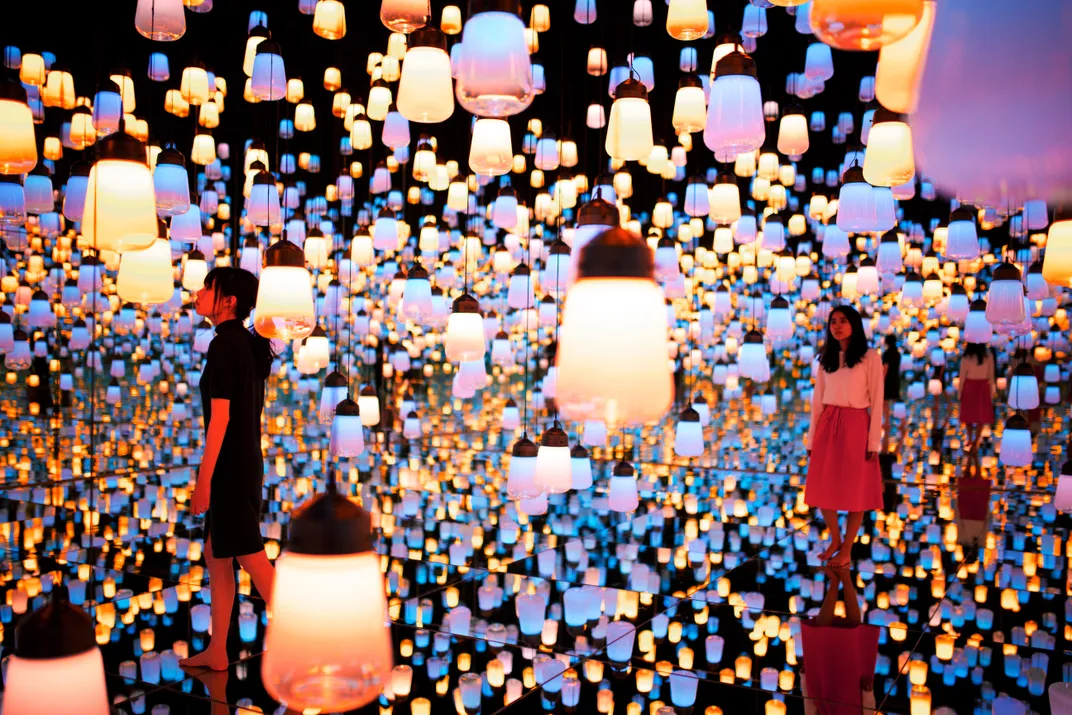Interactive, Digital Art Museum Opens in Tokyo
Touch digital birds, sip flower tea and more at the world’s largest digital art museum
/https://tf-cmsv2-smithsonianmag-media.s3.amazonaws.com/filer/35/39/35399575-62c7-41cb-bda3-1b0a9f7cca8b/main_borderlesswaorl_takihana_2_3_high.jpg)
A new art museum has opened in Tokyo, and visitors are invited to touch the art. The creators say the new museum is the world's largest dedicated to digital, interactive art.
MORI Building DIGITAL ART MUSEUM: teamLab Borderless, in Tokyo’s Odaiba district, combines science, art, technology, design and images of the natural world with simulations generated by 520 computers and 470 high-tech projectors. With over 107,000 square feet of space, the museum has 50 interactive displays that blend into one another over five different zones. The exhibit’s “borderless” name encourages breaking down barriers – barriers between one piece of art and another, art and its visitors, and one person and another.
The museum is a partnership between Mori Building, a developer, and TeamLab, an art collective.
“If an artist can put thoughts and feelings directly into people’s experiences, artworks too can move freely, form connections and relationships with people, and have the same concept of time as the human body,” Toshiyuki Inoko, founder of teamLab, says in a press release. “Artworks can transcend boundaries, influence and sometimes intermingle with each other. In this way, all the boundaries between artist, people and artworks, dissolve and the world teamLab Borderless is created.”
There are five connected zones in the museum. “Borderless World,” the first zone, is an interactive digital landscape where visitors are encouraged to create their own path. People walk through digitized waterfalls, “touch” luminescent birds and saunter through computer generated forests and fields.
“Time here changes constantly – the seasons and flower forests are always changing,” Inoko explains to The Telegraph’s Danielle Demetriou. “It exists now but you’ll never be able to see it exactly the same way again.”
The second zone is the “Athletics Forest,” a zone intended to train the brain’s spatial recognition abilities and get people moving, according to teamLab. The space has visitors climbing on flashing poles, bouncing on a trampoline through a galaxy simulation and balancing on hanging boards that dangle in a show of colorful lights.
“Future Park” is designed for children. The park has kids interact with the art through various games and activities, such as an aquarium teeming with digital fish designed by the kids themselves and a musical wall that plays sounds upon touch. The activities are designed to help expand the imagination and teach scientific concepts.

Moving from the park, the exhibition turns into the “Forest of Lamps.” Visitors stand engulfed in a sea of colorful lamps where light spreads from one lamp to the next once a lamp is touched. The final experience is calmer, as guests in “En Tea House” sip cups of green tea while augmented reality technology makes digital flowers bloom inside their cups. Through the communal act of enjoying tea, the exhibition encourages visitors to talk to one another.
“We immerse and meld ourselves into this unified world,” Inoko says in the press release. “We explore a new relationship that transcends the boundaries between people, and between people and the world.”
The museum currently costs 2,400 Japanese Yen (or roughly 21.82 USD) per adult to enter. If that seems expensive, it’s due to the costs of creating the art. "The production costs of building the immersive environments, and the tech team required to make it work, are really substantial -- often millions of dollars,” Peter Boris, executive vice president of Pace Gallery – which has hosted four teamLab exhibitions – explains to CNN’s Stephy Chung. “The business model becomes more like entertainment, movies, theater, music (so) we have made it work by selling tickets."
The museum’s five different spaces are on permanent display, though the nature of digitized art means the installations will be constantly changing.